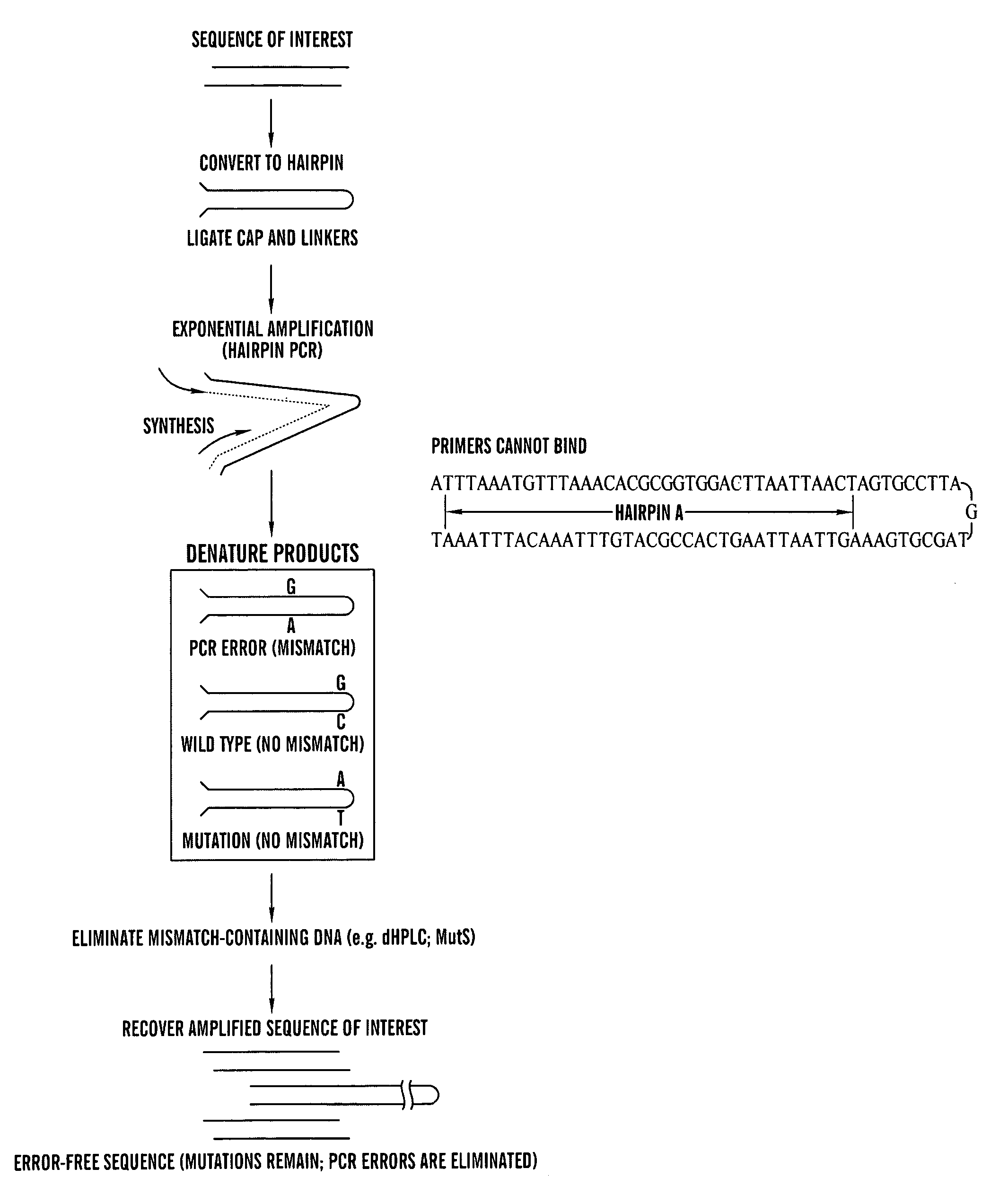Amplification of DNA in a hairpin structure, and applications
a technology of nucleic acid structure and dna, applied in the field of hairpin nucleic acid structure, can solve the problems of inability to detect such mutations, inability to clone dna and protein functional analysis by in vitro translation, and invariably generate errors of polymerases during amplification, so as to achieve the effect of large dna amplification
- Summary
- Abstract
- Description
- Claims
- Application Information
AI Technical Summary
Benefits of technology
Problems solved by technology
Method used
Image
Examples
example 1
Amplification of Hairpins Using Polymerase Chain Reaction (PCR) Hairpin-Forming, Long Oligonucleotides
[0061]Five long oligonucleotides expected to form hairpins were synthesized by Oligos Etc and HPLC-purified (Oregon, USA). The sequence of hairpins A and D (SEQ ID NOs:1 and 2, respectively) are depicted in FIGS. 1B-C. Sequences of hairpin B (SEQ ID NO:3), hairpin C (SEQ ID NO:4), and hairpin E (SEQ ID NO:5), which were designed to contain non-complementary ends like hairpin D, were:
[0062]
Hairpin B:5′ ACC GAC GTC GAC TAT CCG GGA(SEQ ID NO:3)ACA CAT GAT TTA AAT GTT TAA ACACGC GGT GGA CTT AAT TAA CTA GTGCCT TAG GTA GCG TGA AAG TTA ATTAAG TCA CCG CAT GTT TAA ACA TTTAAA TGT ACA GCA CTC TCC AGC CTCTCA CCG CA 3′;Hairpin C:5′ ACC GAC GTC GAC TAT CCG GGA(SEQ ID NO:4)ACA CAA GAT TTA AAT GTT TAA ACACGC GGT GAC TTA ACA GGC GCG CCTTAA CTA GTG CCT TAG GTA GCG TGAAAG TTA AGG CGC GCC TGT TAA GTCACC GCG TGT TTA AAC ATT TAA ATCTTG AGC ACT CTC CAG CCT CTC ACCGCA 3′;Hairpin E:5′ ACC GAC GTC GAC TAT CC...
example 2
Amplification of Hairpins Using Rolling-Circle Amplification
[0077]FIG. 6 shows amplification of hairpins using rolling-circle amplification (RCA). The hairpin-shaped oligonucleotide of FIG. 6A was self-ligated to form a closed ‘dumbbell-like’ structure resembling the structures used for RNA-interference. The dumbbell was then amplified in an isothermal rolling-circle amplification reaction using Phi29 polymerase (from New England Biolabs) and random primers. Following digestion of the RCA product with Alu, the amplified hairpin-dimer DNA was recovered. FIG. 6B shows in lane 1, no Alu digestion; in lane 2, digestion with Alu. The amplification is about 1000-fold. In another example, the hairpin-shaped oligonucleotide of FIG. 6C was self-ligated to form a closed ‘dumbbell-like’ structure, and then amplified in an isothermal rolling-circle amplification reaction using Phi29 polymerase (from New England Biolabs) and random primers. Following digestion of the RCA product with Nla-III, th...
PUM
| Property | Measurement | Unit |
|---|---|---|
| volume | aaaaa | aaaaa |
| final volume | aaaaa | aaaaa |
| final volume | aaaaa | aaaaa |
Abstract
Description
Claims
Application Information
 Login to View More
Login to View More - R&D
- Intellectual Property
- Life Sciences
- Materials
- Tech Scout
- Unparalleled Data Quality
- Higher Quality Content
- 60% Fewer Hallucinations
Browse by: Latest US Patents, China's latest patents, Technical Efficacy Thesaurus, Application Domain, Technology Topic, Popular Technical Reports.
© 2025 PatSnap. All rights reserved.Legal|Privacy policy|Modern Slavery Act Transparency Statement|Sitemap|About US| Contact US: help@patsnap.com



